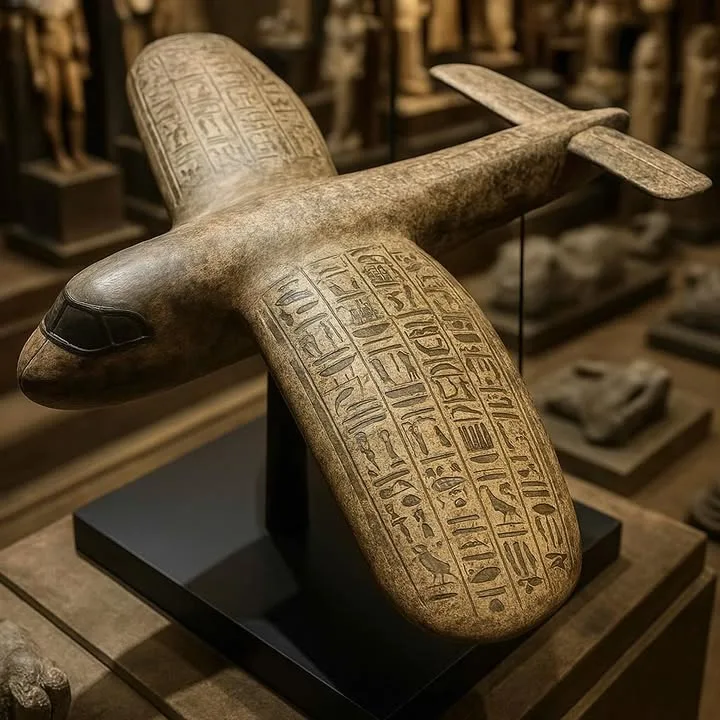Deep within a collection of ancient Egyptian artifacts, nestled in a setting reminiscent of a museum, lies an object that defies comprehension. Crafted in the shape of a sleek, modern aircraft—complete with a cockpit-like structure, wing formations, and tail stabilizers—this enigmatic relic is adorned with intricate hieroglyphs, merging the aesthetic of pharaonic Egypt with the aerodynamics of 20th-century engineering. Unearthed among relics over three millennia old, it poses a haunting question: How could a civilization from 3,000 years ago conceive a form so eerily aligned with modern aerospace technology?

A Design Ahead of Its Time
The artifact’s form is striking. Its streamlined body, suggestive of a fuselage, flows into wings that mirror the proportions of modern gliders or small aircraft. A distinct tail section, complete with stabilizers, enhances its aerodynamic profile, while a forward structure resembles a cockpit. These features draw inevitable comparisons to the Saqqara Bird, a 2,200-year-old wooden artifact discovered in 1898 near Saqqara’s Step Pyramid. The bird, often dismissed as a toy or ceremonial object, has been debated for its aerodynamic qualities, with some experiments suggesting it could glide under specific conditions. Yet, this newly described artifact surpasses the Saqqara Bird in sophistication, blending precise engineering with the unmistakable artistry of ancient Egypt.
What sets this object apart are the hieroglyphs etched across its surface. These carvings, meticulously detailed, evoke the symbolic language of the pharaohs—cartouches, ankhs, and other motifs associated with divine power and celestial journeys. Are these merely decorative, or do they encode a deeper narrative? Could they describe the object’s purpose, its mythological significance, or—most tantalizingly—technical knowledge lost to time?
Theories and Controversies
Conventional scholars are quick to label the artifact a modern forgery or an artist’s whimsical creation. After all, the idea of ancient Egyptians conceptualizing flight challenges the established timeline of technological progress. Egyptologists argue that such objects, like the Saqqara Bird, may represent stylized birds or symbolic tributes to deities like Horus, the falcon-headed god of the sky. The hieroglyphs, they suggest, are likely ceremonial, aligning the object with religious or funerary contexts rather than practical engineering.
Yet, the artifact’s uncanny resemblance to modern aircraft invites bolder interpretations. Proponents of ancient astronaut theories, popularized by figures like Erich von Däniken, propose a provocative alternative: Could this object reflect ancestral memories of advanced technology, perhaps observed or even gifted by extraterrestrial visitors? The hieroglyphs, in this view, might encode encounters with “celestial chariots” or serve as a ritualized record of otherworldly knowledge. While mainstream archaeology dismisses such claims as speculative, the artifact’s fusion of futuristic design and ancient script fuels their arguments.
A middle ground exists in the idea of symbolic innovation. Ancient Egyptians were masterful observers of nature, as seen in their architectural precision and astronomical knowledge. Could the artifact represent an early attempt to mimic the flight of birds, inspired by myths of divine travel or celestial ascent? The hieroglyphs might then serve as a narrative bridge, linking the object to stories of gods traversing the heavens.
A Challenge to History
The artifact disrupts our linear assumptions about technological progress. If genuine, it suggests that ancient minds may have grasped concepts of aerodynamics long before the Wright brothers’ first flight in 1903. Experimental archaeology, like tests conducted on replicas of the Saqqara Bird, has shown that ancient designs could achieve limited flight, hinting at a rudimentary understanding of lift and glide. Could this hieroglyphic aircraft be a more advanced iteration, perhaps a prototype or a ceremonial model inspired by lost knowledge?
Alternatively, the artifact may be a modern creation—a hoax designed to provoke or an artistic homage to Egypt’s enduring mystique. Yet, even as a forgery, it forces us to confront the limits of our understanding. The precision of its design and the authenticity of its hieroglyphs demand scrutiny. If crafted in antiquity, it could point to an obscured chapter in human history, where advanced ideas briefly surfaced before fading into obscurity.
The Lingering Mystery
The hieroglyphic aircraft stands as a testament to the enduring allure of ancient Egypt—a civilization that continues to surprise and challenge us. Whether it’s a forgotten experiment, a symbolic relic, or an elaborate fiction, its existence invites us to question what we believe about the past. Are the hieroglyphs a decorative flourish, a ceremonial code, or a cryptic manual for a technology we’ve yet to fully understand? Could this artifact hint at a world where ancient minds dreamed of flight, inspired by gods, nature, or something stranger?
As it rests among its ancient counterparts, this object whispers of possibilities we may never fully grasp. It is a reminder that history is not a straight line but a tapestry of mysteries, waiting for those bold enough to unravel its threads.
Sources: Inspired by discussions of the Saqqara Bird and ancient Egyptian artifacts, with additional context from archaeological debates and alternative history theories, accessed August 22, 2025.





